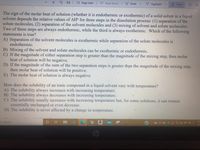

1.) To explain which of the following statement is true for molar heat of solution during dissolution process.
Three steps in the dissolution process
1) separation of the solute molecules,(endothermic)
2.) separation of the solvent molecules, (endothermic)
3.) mixing of solvent and solute molecules (exothermic)
the sign of molar heat of solution can be positive or negative, which depends on :
- if more energy is required for separation of solute and solvent molecules.
- if more energy was released on mixing of solute and solvent molecules.
Now, the overall process is exothermic (negative) if more energy is released in mixing of solvent and solute molecules than is used in separation of solute and solvent molecules. The overall process in endothermic (positive), if more energy is used in separation of solute and solvent molecules than is released upon mixing of solute and solvent molecules.
Thus, we can say that if the magnitude of the sum of the two separation steps is greater than the mixing step, then molar heat of solution will be positive.
Hence, option D) is correct.
Trending nowThis is a popular solution!
Step by stepSolved in 2 steps

- Please don't provide handwritten solution .....arrow_forwardLithium chloride has a solubility of 45.80 g in 100. g of water at 25°C. Express this solubility in terms ofmass percent molality mole fractionarrow_forward5.152g of Na2CO3(s) is added to 75.0mL of water at 21.20°C. When the dissolution is complete, the final temperature of the solution is measured at 25.00°C. The final volume of the solution is 75.8mL, and the density of water at 21.20°C is 0.99798g/mL. Identify the strongest intermolecular force present in Na2CO3(s): and in water:arrow_forward
- An experiment was conducted to determine the effect of glucose on the freezing point of water. Experimental data showed thatthe freezing point depression of water in solution was –2.6°C when 1.0 g of glucose was dissolved in 10g of solvent. Calculatethe expected freezing point for such solution and compare the expected freezing point to the value found experimentally. Give aplausible explanation for any discrepancies. (M.W. of glucose= 180.16g/mol; i=1). Show all your work.arrow_forward9.) Using the data below (tabulated at 25 °C), what is the vapor pressure, in kilopascals (kPa), of a solution formed by mixing 5.37 mol of iodomethane (CH3I) with 4.27 mol of trichloromethane (CHCl3) at 25 °C? Assume ideal behavior. Substance Vapor Pressure (kPa) Iodomethane 53.9 Trichloromethane 26.2arrow_forwardThe solubility of carbon dioxide in water at 25°C and 1 atm is 0.034 mol/L. What is its solubility in (mol/L) under condition of a partial pressure of 19 psi?arrow_forward
- At a certain temperature the vapor pressure of pure benzene and pure toluene are 380 torr and 130 torr, respectively. If the mole fraction of benzene is 0.48, what is the total vapor pressure.arrow_forwardAt a certain temperature, diethyl ether has a vapor pressure of 550.0 torr. When a sample of benzoic acid (a non-volatile compound) is dissolved in ether, the vapor pressure of the solution is 486 torr. What is the mole fraction of benzoic acid in the solution?arrow_forwardWhen 4.59 g of a certain molecular compound X are dissolved in 35. g of dibenzyl ether ((C%H,CH,),°). the freezing point of the solution is measured to be 0.9 °C. Calculate the molar mass of X. If you need any additional information on dibenzyl ether, use only what you find in the ALEKS Data resource. Also, be sure your answer has a unit symbol, and is rounded to 1 significant digit. 0 00 0.0 X x10arrow_forward
- An experiment conducted at 20 oC requires an atmosphere in which the partial pressure of water is a constant 10.0 torr. The experiment will be conducted inside a sealed container in which there is a beaker containing a solution of ethylene glycol (FW 62.07) and water (FW 18.02). At 20 oC, the vapor pressure of pure ethylene glycol is 0.056 torr and that of pure water is 17.3 torr. What mass of ethylene glycol must be mixed with 200. g water to produce a solution with a 10.0 torr vapor pressure of water? (Report the answer to three significant figures.)arrow_forwardWhen 98.9 g of glycine (C₂H5NO₂) are dissolved in 900. g of a certain mystery liquid X, the freezing point of the solution is 4.7 °C lower than the freezing point of pure X. On the other hand, when 98.9 g of iron(III) nitrate = (Fe(NO3)3): are dissolved in the same mass of X, the freezing point of the solution is 5.4 °C lower than the freezing point of pure X. Calculate the van't Hoff factor for iron(III) nitrate in X. Be sure your answer has a unit symbol, if necessary, and round your answer to 2 significant digits. i= 0arrow_forwardThe organic compounds chloroform and dichloromethane form ideal solutions when mixed together; at 25 �C the total vapor pressure from a mixture of these two compounds was 345.322 torr. What is the mole fraction of chloroform? Given that the vapor pressure of pure chloroform and pure dichloromethane are 205 torr and 415 torr, respectively, at 25�C. 0.6682 0.4430 0.3318 0.5570arrow_forward
 ChemistryChemistryISBN:9781305957404Author:Steven S. Zumdahl, Susan A. Zumdahl, Donald J. DeCostePublisher:Cengage Learning
ChemistryChemistryISBN:9781305957404Author:Steven S. Zumdahl, Susan A. Zumdahl, Donald J. DeCostePublisher:Cengage Learning ChemistryChemistryISBN:9781259911156Author:Raymond Chang Dr., Jason Overby ProfessorPublisher:McGraw-Hill Education
ChemistryChemistryISBN:9781259911156Author:Raymond Chang Dr., Jason Overby ProfessorPublisher:McGraw-Hill Education Principles of Instrumental AnalysisChemistryISBN:9781305577213Author:Douglas A. Skoog, F. James Holler, Stanley R. CrouchPublisher:Cengage Learning
Principles of Instrumental AnalysisChemistryISBN:9781305577213Author:Douglas A. Skoog, F. James Holler, Stanley R. CrouchPublisher:Cengage Learning Organic ChemistryChemistryISBN:9780078021558Author:Janice Gorzynski Smith Dr.Publisher:McGraw-Hill Education
Organic ChemistryChemistryISBN:9780078021558Author:Janice Gorzynski Smith Dr.Publisher:McGraw-Hill Education Chemistry: Principles and ReactionsChemistryISBN:9781305079373Author:William L. Masterton, Cecile N. HurleyPublisher:Cengage Learning
Chemistry: Principles and ReactionsChemistryISBN:9781305079373Author:William L. Masterton, Cecile N. HurleyPublisher:Cengage Learning Elementary Principles of Chemical Processes, Bind...ChemistryISBN:9781118431221Author:Richard M. Felder, Ronald W. Rousseau, Lisa G. BullardPublisher:WILEY
Elementary Principles of Chemical Processes, Bind...ChemistryISBN:9781118431221Author:Richard M. Felder, Ronald W. Rousseau, Lisa G. BullardPublisher:WILEY





